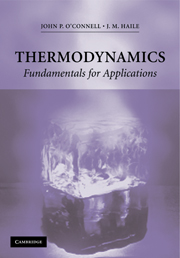Book contents
- Frontmatter
- Contents
- Preface
- Acknowledgments
- THERMODYNAMICS: Fundamental for Applications
- 0 Introduction
- PART I THE BASICS
- PART II SINGLE-PHASE SYSTEMS
- 4 Properties Relative to Ideal Gases
- 5 Properties Relative to Ideal Solutions
- 6 Relations Among Relations
- PART III MULTIPHASE AND REACTING SYSTEMS
- PART IV ENGINEERING CALCULATIONS
- APPENDICES
- Notation
- Index
6 - Relations Among Relations
Published online by Cambridge University Press: 05 June 2012
- Frontmatter
- Contents
- Preface
- Acknowledgments
- THERMODYNAMICS: Fundamental for Applications
- 0 Introduction
- PART I THE BASICS
- PART II SINGLE-PHASE SYSTEMS
- 4 Properties Relative to Ideal Gases
- 5 Properties Relative to Ideal Solutions
- 6 Relations Among Relations
- PART III MULTIPHASE AND REACTING SYSTEMS
- PART IV ENGINEERING CALCULATIONS
- APPENDICES
- Notation
- Index
Summary
In previous chapters we have introduced many quantities, and we have developed many relations among those many quantities. We use this chapter to summarize the most important of those relations and to show you that we have consistently used a single approach in developing those relations. We start in § 6.1 by reminding you of the subtle distinctions between system states and constraints on interactions that may be in force when we change a state. Constraints are usually imposed in terms of measurables; for example, constant temperature or constant volume or no heat transfer. But such constraints can have profound effects on conceptuals and, in particular, on our choices for the most useful and economical expressions for relating measurables to conceptuals.
At this point we have developed two principal ways for relating conceptuals to measurables: one based on the ideal gas (Chapter 4) and the other based on the ideal solution (Chapter 5). Both routes use the same strategy—determine deviations from a well-defined ideality—with the deviations computed either as differences or as ratios. Since both routes are based on the same underlying strategy, a certain amount of symmetry pertains to the two; for example, the forms for the difference measures—the residual properties and excess properties—are functionally analogous.
We use § 6.2 to emphasize the symmetries that exist among difference measures and among ratio measures. Difference measures are commonly used to compute thermodynamic properties of single homogeneous phases, while ratio measures are most often used in phase and reaction equilibrium calculations.
- Type
- Chapter
- Information
- ThermodynamicsFundamentals for Applications, pp. 228 - 254Publisher: Cambridge University PressPrint publication year: 2005



